
Lot 26
![[COLLECTION OF PROF. J. GILBERT & CORA MCALLISTER] CHINESE ENAMELLED PORCELAIN 'GRASSHOPPER' SNUFF BOTTLE](https://media.app.artisio.co/media/104cbde6-0d38-43cb-9e0f-bb721ef57bcf/inventory/265a9e83-6ad7-4719-86c1-1af0807dbf3a/faaa7446-a707-42d2-9175-cd5227f0729d/00001_ojJbbc_original.jpeg)
[COLLECTION OF PROF. J. GILBERT & CORA MCALLISTER] CHINESE ENAMELLED PORCELAIN 'GRASSHOPPER' SNUFF BOTTLE
QING DYNASTY, DAOGUANG FOUR-CHARACTER SEAL MARK IN IRON RED AND OF THE PERIOD
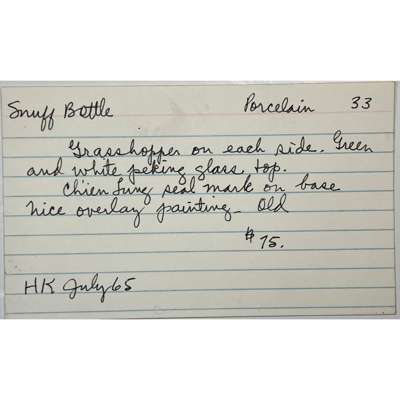
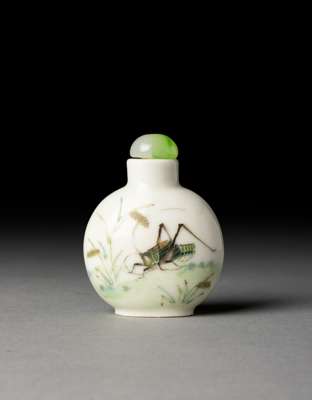
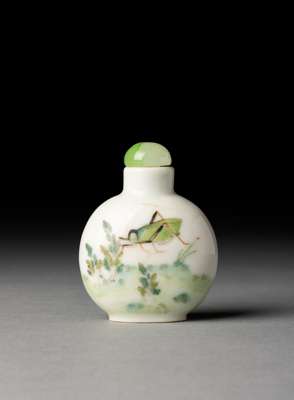
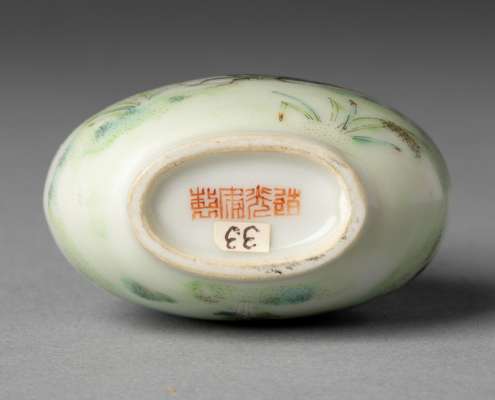
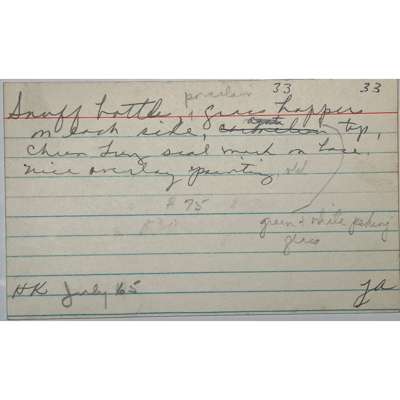





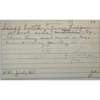
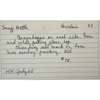
Auction: 07 November 2025 from 10:00 GMT
Description
清道光 礬紅四字「道光年製」篆書款 瓷胎粉彩蟈蟈鼻煙壺
of compressed globular form rising from a hollowed oval foot to a cylindrical neck, painted on both sides with a grasshopper standing on a green grass ground, the base inscribed with a four-character Daoguang mark in seal script in iron red, with stopper
Dimensions
height: 5.5cm; 6.1 cm with stopper
Provenance
Collection of Prof. J. Gilbert & Cora McAllister, thence by descent based in England. With collector's handwritten note and Collector's Number 33, acquired in July 1965 probably via ES in Hong Kong (Hai Tan Arts).
Dr. J. Gilbert McAllister (1904–1993) was Emeritus Professor in Anthropology at the University of Texas. Primarily a cultural anthropologist, he also carried out significant archaeological research. Cora McAllister (1904-1995) graduated from the University of Texas in 1924 as a Member of Phi Beta Kappa. In 1933–1934, she and Gilbert lived amongst Kiowa-Apache Indians in Oklahoma, where Gilbert conducted field research. In 1935, Gilbert was lured back to the University of Texas, where, by 1935, he became Chairman of the department and head of a large archaeological program. There, Gilbert (or Dr. Mac as he was affectionately known by his students) made his name as an archaeological administrator and especially as a remarkable teacher for over 33 years until his retirement in 1968. In a Memorial Resolution Committee Memorandum, it is noted that he had a “massive integrity about him” and “we talk about role models these days. He was one of the good ones.”
Cora and Gilbert’s large and eclectic collection was informed by a deep love for Asian cultures and antiquities, coupled with a scholarly approach. Their collection spanned vast time periods, materials, and included cultures of China, Japan, Korea, Southeast Asia and more. The collection was mostly acquired in the 1960s and 1970s, variously from Cora and Gilbert’s friends and fellow academics who made trips to Asia (some of whom were commissioned specifically by Gilbert), their usual dealers and contacts, as well as from fellow collectors.
For more information about Dr and Ms McAllister, please visit: https://shaybo-therisingtide.blogspot.com/2014/08/j-gilbert-mcallister-memorial.html?m=1
Footnote
The appearance of grasshoppers or katydids became a popular subject matter for decorations on snuff bottles during the late Qianlong period, mostly seen on the enamelled-glass wares which bear guyuexuan marks. However, it was during the Daoguang period when the design permeated into the Imperial court as a favoured subject. The popularity of the design is also considered a by-product of the fashion for selecting and breeding the finest fighting crickets in the Daoguang period. Compare a snuff bottle of similar design from the Mary and George Bloch collection, illustrated in Moss, Graham and Tsang, A Treasury of Chinese Snuff Bottles: The Mary and George Bloch Collection, Vol.6, Arts of the Fire, Hong Kong, 2008, pp.690-691, no.1318, sold at Bonhams Hong Kong, 28 November 2011, lot 164. Another example from The Paul Braga Collection was sold at the same saleroom, 24 November 2012, lot 96.











